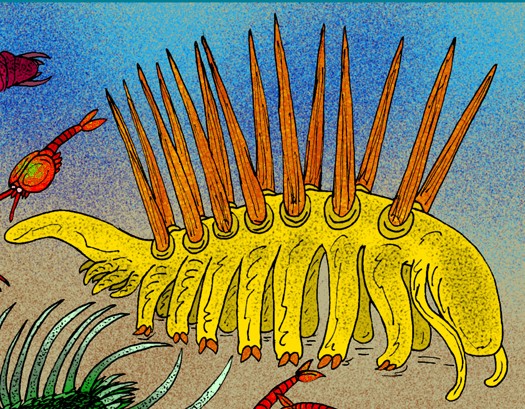Scientists Discover the Truth About One of the Oddest Fossils Ever Found
| Marc Maligalig | | Aug 20, 2014 01:56 PM EDT |
(Photo : Wikimedia Commons)
Researchers at the University of Cambridge in England have linked one of the strangest fossils ever discovered, known as Hallucigenia, to present worm-like animals that inhabit tropical rainforests.
The Hallucigenia was a peculiar worm equipped with legs that lived on the ocean floor over 500 million years ago before the species died out. Scientists have been confused for decades on how to classify the extinct animal.
Like Us on Facebook
While the animal's fossils were unearthed in the 1970s, the scientists had no clue on what creature they were looking at. What the researchers initially thought to be the tentacles along its back are now known to be the Hallucigenia's legs, and its legs are actually spines along the animal's back.
Dr. Martin Smith, one of the study's researchers and scientist at Cambridge's department of earth sciences, and his colleagues found likenesses between velvet worms and the claws. The layers of the extinct animal's cuticle were stacked together.
The study on the fossils has given noteworthy insights into the evolutionary tree of the phylum Arthropoda, which includes insects, arachnids and crustaceans.
"Most gene-based studies suggest that arthropods and velvet worms are closely related to each other; however, our results indicate that arthropods are actually closer to water bears, microscopic water-dwelling animals", said Dr. Javier Ortega-Hernandez, co-author of the study.
Dr. Smith said that the results have paved the way for scientists to comprehend how the evolution of various animals took place as time went on. It has also been proposed by majority of the prior gene-based classification studies that there is a strong affinity between velvet worms and arthropods.
Members of the phylum are strongly related to tardigrades, a group of microscopic stalwart creatures that are able to survive in environments where sub-zero temperatures are the norm.
The Hallucigenia fossils were discovered in the Burgess Shale, in the Rocky Mountains of Canada
TagsFossil, Paleontology, Cambrian, Arthropod, Worm, Science, scientific research
©2015 Chinatopix All rights reserved. Do not reproduce without permission
EDITOR'S PICKS
-

Did the Trump administration just announce plans for a trade war with ‘hostile’ China and Russia?
-

US Senate passes Taiwan travel bill slammed by China
-

As Yan Sihong’s family grieves, here are other Chinese students who went missing abroad. Some have never been found
-

Beijing blasts Western critics who ‘smear China’ with the term sharp power
-

China Envoy Seeks to Defuse Tensions With U.S. as a Trade War Brews
-

Singapore's Deputy PM Provides Bitcoin Vote of Confidence Amid China's Blanket Bans
-

China warns investors over risks in overseas virtual currency trading
-

Chinese government most trustworthy: survey
-

Kashima Antlers On Course For Back-To-Back Titles
MOST POPULAR
LATEST NEWS
Zhou Yongkang: China's Former Security Chief Sentenced to Life in Prison

China's former Chief of the Ministry of Public Security, Zhou Yongkang, has been given a life sentence after he was found guilty of abusing his office, bribery and deliberately ... Full Article
TRENDING STORY

China Pork Prices Expected to Stabilize As The Supplies Recover

Elephone P9000 Smartphone is now on Sale on Amazon India

There's a Big Chance Cliffhangers Won't Still Be Resolved When Grey's Anatomy Season 13 Returns

Supreme Court Ruled on Samsung vs Apple Dispute for Patent Infringement

Microsoft Surface Pro 5 Rumors and Release Date: What is the Latest?










